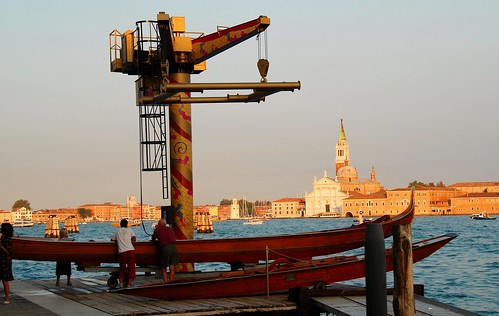Venice – Where Building and Restoring Gondolas Can Be an Uplifting Experience!
Venice – Where Building and Restoring Gondolas Can Be an Uplifting Experience!

Image by antonychammond
There are some 450 authorized gondoliers distributed over the five hundred gondolas in the city, just a few if compared to the 10,000 boatmen who plied the waters of Venice at the time of Goldoni, but a good number considering that there are around 2500 taxis are in Milan. These facts show that in the end, the traffic along the Venetian canals has not changed substantially since the Renaissance, as has happened in other cities instead.
This is why Gondolas and Squeri are so important to Venice’s economy. The squeri are the famous workshops where gondolas are manufactured and undergo maintenance. Originally, these workshops were all located on the Grand Canal, just to make their overriding importance and centrality to the city’s needs, but nowadays only two of them still exist in the center of Venice: San Trovaso and Tramontin.
San Trovaso Squero is even legendary, as its existence is documented since Goldoni’s times, but the oldest is surely the Tramontin Squero, as the Tramontin family has been handing down the art since 1884 and has been the pioneer of the modernization of construction techniques, renewing methodologies used since the 1500s and 1600s.
The construction technique of gondolas is virtually unchanged since the days of Giovanni Tramontin, great- great-grandfather to Roberto, who said he was so skilled in his work that he made a bet with his student Alberto Mingaroni and fashioned a gondola in a single night.
Who knows if it was a legend or a real story, but certainly nowadays his grandchildren need to work for hundreds of hours to build a gondola in a workmanlike manner, as each one is a unique piece. Indeed, each gondolier has his own gondola and each boat is customized to its gondolier, to his weight and height – indeed, it is no coincidence that the weight of the iron bow varies according to the size of the gondolier and serves as a mass balancer. Also the steering position, the oar and the forcola where it rests are designed and manufactured considering the height and the arms of the gondolier. This need to customize gondolas is not an artistic habit, but rather responds to its peculiar navigation technique based on arm strength. This technique is very complex and relies on experience and direct knowledge of the routes, channels and pitfalls, however, quite different from any other traditional navigation mode.
For further information please visit www.thatsvenice.com/travel-guides/squeri/
Venice (Italian: Venezia [veˈnɛttsja] ( listen), Venetian: Venexia [veˈnɛsja]) is a city in northeast Italy which is renowned for the beauty of its setting, its architecture and its artworks. It is the capital of the Veneto region. In 2009, there were 270,098 people residing in Venice’s comune (the population estimate of 272,000 inhabitants includes the population of the whole Comune of Venezia; around 60,000 in the historic city of Venice (Centro storico); 176,000 in Terraferma (the Mainland), mostly in the large frazioni of Mestre and Marghera; 31,000 live on other islands in the lagoon). Together with Padua and Treviso, the city is included in the Padua-Treviso-Venice Metropolitan Area (PATREVE) (population 1,600,000).
The name is derived from the ancient Veneti people who inhabited the region by the 10th century B.C. The city historically was the capital of the Venetian Republic. Venice has been known as the "La Dominante", "Serenissima", "Queen of the Adriatic", "City of Water", "City of Masks", "City of Bridges", "The Floating City", and "City of Canals". Luigi Barzini described it in The New York Times as "undoubtedly the most beautiful city built by man". Venice has also been described by the Times Online as being one of Europe’s most romantic cities.
The city stretches across 117 small islands in the marshy Venetian Lagoon along the Adriatic Sea in northeast Italy. The saltwater lagoon stretches along the shoreline between the mouths of the Po (south) and the Piave (north) Rivers.
The Republic of Venice was a major maritime power during the Middle Ages and Renaissance, and a staging area for the Crusades and the Battle of Lepanto, as well as a very important center of commerce (especially silk, grain, and spice) and art in the 13th century up to the end of the 17th century. This made Venice a wealthy city throughout most of its history. It is also known for its several important artistic movements, especially the Renaissance period. Venice has played an important role in the history of symphonic and operatic music, and it is the birthplace of Antonio Vivaldi.
Please visit en.wikipedia.org/wiki/Venice for further information…